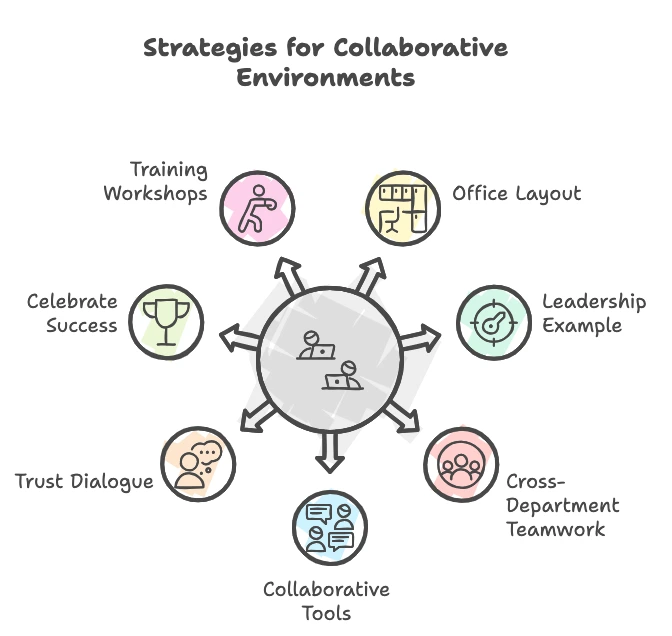Jump to the section
Key Learnings
#1
Practice Positive Leadership
Positive leadership is about creating a supportive environment where team members feel valued and motivated. By open dialogue and encouraging growth, leaders can build trust.
#2
Communicate Clearly
Clear communication eliminates confusion and ensures that everyone is aligned with the team’s goals. Transparent interactions build trust and facilitate effective collaboration.
#3
Design your Teamwork
Creating spaces that encourage teamwork can break down barriers and promote innovation. Whether physical or virtual, collaborative environments strengthen team bonds and build trust.
#4
Foster a Growth Mindset
Encouraging a culture of continuous learning shows commitment to employees’ development. When leaders invest in their team’s growth, it fosters trust and promotes a culture of continuous learning.

Imagine that you walk to the office and immediately feel excited. Your team is highly motivated to work together. Does it sound like a scenario? But the reality is that this scenario is not as far away as it seems.
Positive leadership can turn every workplace into a dynamic, innovative environment. It is where people feel valued and inspired. But you are not building trust instantly. Trust can be gained through actions, clear communication, and consistent behaviors. Whether you are an experienced leader or just stepping into the role, trust is something that you can cultivate over time and apply the right leadership strategies. It requires specific consistent actions and behaviors.
If you are ready to move on and learn how to build trust with your team and about positive leadership, you are at the right place. In this article, you will learn about motivational quotes, mastering clear communication, and designing collaborative spaces for creativity. We provide actionable insights to foster trust and lead your team to success.
How to practice Positive Leadership?
Positive leadership is not just about being optimistic and upbeat, it is about creating a positive environment where people are supported, inspired, and motivated to bring their best. Trust is the bond among people, and positive leaders understand how to cultivate trust through daily actions and behaviors. When leaders cultivate a trustworthy environment, it creates a ripple effect throughout the team. This improves motivation at work and overall team productivity.

Use the power of positive quotes
Words are important to build impressions and shape the mindset of people. Motivational quotes for the work are simple and powerful tools that positive leaders can use to lift their teams. A nice motivational quote at the right time can turn around someone’s day, especially during challenging days.
“The greatest leader is not necessarily the one who does the greatest things. He is the one that gets the people to do the greatest things.” – Ronald Reagan
This quote from Ronald Reagan reminds us that leadership and motivation are deeply interrelated. Great leaders empower others to grow and shine. This builds trust and inspires people to bring their best at work.
When motivation phrases for work are used correctly and genuinely, can give team members the boost to overcome obstacles. Another great motivational quote comes from Theodore Roosevelt. This gives a leadership paradigm for how deeply impact has a motivational quote to our mindset.
“Believe you can and you’re halfway there.” – Theodore Roosevelt
Encourage Growth and Resilience
Positive leadership goes beyond motivational quotes and words. It is mainly setting a culture for growth and resilience as part of everyday experience. Leaders who consistently encourage and lift their teams can build the foundation for trust. The following quote demonstrates that positivity should come within you as intrinsic motivation.
“The only way to do great work is to love what you do” – Steve Job
Inspirational quotes for work motivation like these can remind the team that during hard times they need to find their sense of purpose and inner motivation for growth.
Lead by Example
One of the most important traits of a positive leader is to lead by example. By consistently demonstrating positivity and achievement, leaders can motivate their teams to follow. The sense of achievement and purpose can provide satisfaction at work and motivate to go the extra mile. Positive leaders do not preach their optimism but they live and demonstrate it. In this way, they earn trust and inspire loyalty in their team.
“Example is not the main thing in influencing others. It is the only thing.” – Albert Schweitzer
Create a Culture of Trust
The fundamentals of positive leadership are trust and building an encouraging workplace. Positive leaders know how to balance constructive feedback with genuine appreciation. Positive leaders know how to provide constructive feedback while providing genuine appreciation. They foster an environment where people feel valued and heard. Recognition and encouragement can strengthen this safe environment that fuels motivation.
“People work for money but go the extra mile for recognition, praise, and rewards.” – Dale Carnegie
How to provide Clear Directions?
Clear communication is key to team success. When leaders provide clear direction for work, they can reduce confusion and mistakes. They also build strong relationships with their team through clarity and direction. Then people feel more confident as they perform based on clear expectations. The result is more collaboration and productivity gains. Here we provide practical tips and strategies for ensuring workplace clarity and avoiding miscommunication.

1. Be Specific and Concise
When it comes to instructions and direction the leader needs to be specific and concise. Vague instruction can lead to misunderstandings and mistakes. Also, it can lead to people not feeling safe in the workplace. Instead of saying to make something better, provide concrete feedback on your expectations and the results step by step. This leaves no room for interpretations, or loops and ensures that everyone knows what needs to be done and delivered.
2. Use Multiple Communication Channels
Not every person works in the same way or interprets information the same way. Some might prefer written communication, some verbal discussion, and some more analytical instructions. That is why the leader has to adapt to multiple communication methods to meet each person’s needs. For example, it will help that after a meeting, you must write an email summary and attach a visual timeline. This brings more workplace clarity and ensures that everyone receives the same message.
3. Encourage Questions and Feedback
Open communication and receiving feedback are the most effective strategies for communication and leadership. Ask for questions and feedback so employees feel comfortable and seek clarification when needed. Make practice an “open doors” policy in which everyone is welcome to ask for clarifications or comments. This two-way dialogue helps prevent misunderstandings before they become problems. Regular check-ins and feedback loops can ensure further trust-building and understanding.
4. Set Clear Expectations
Setting clear expectations Is the way to proceed for improving leadership and clear communication. The leader must set specific goals and deadlines. In this way, there is clarity about what success looks like. Using the SMART framework (Specific, Measurable, Achievable, Relevant, Time-Bound) for setting goals the leader makes it easier to understand what is required and how to achieve it.
5. Follow Up and Reinforce
After providing direction for work, do not assume that everything is done or clearly understood by the people. Take some time to follow up and ask the team member to tell you what he understood. Team members should paraphrase her understanding and how to do the task in her own words. This simple follow-up step ensures that everyone is on the same page and allows you to connect for clarification of any misunderstandings.
How to build Teamwork?
When teams come together in spaces specially designed for interaction and collective problem-solving, the results can be significant. These collaborative working spaces have the goal to break the barriers between departments and silos. They allow people from different levels are work together and allow employees to engage in spontaneous exchanges. They can share ideas spontaneously and work together on new ideas. The impact of teamwork on leadership and overall productivity is very positive.

A well-designed collaborative working space fosters an atmosphere of positive leadership and teamwork. Removing the physical barriers encourages organic interactions and improves communication among team members. Open areas promote teamwork and leaders can boost trust within their teams for fostering innovation. These collaborative spaces can offer:
- Increased spontaneous interactions
- Boost knowledge sharing and learning
- Make the team stronger and more cohesive
- Spark creativity and innovation
- Improve employee engagement and morale
How to Create a Collaborative Environment?
Some strategies for achieving teamwork and collaboration in a working environment are the following:

Working space layout design
Ensure the office layout includes spaces for focused work and also collaboration. Open areas should be mixed with quiet zones and places for exchange and brainstorming. Coffee corners are good ideas for bringing people together during breaks.
Lead by example
Once you have created a new layout, use these spaces by yourself to show your team the value of leadership and collaboration. Your actions and tone will set an example for others to follow and use in this environment.
Encourage cross-department teamwork
You have to foster collaboration between teams from different departments and areas. This leads to more aligned cooperation and innovative solutions with broader organizational adoption.
Use collaborative tools
Investing in tools that make collaboration easier could provide numerous benefits. Project management tools, communication platforms, and digital meeting rooms can offer improved collaboration. Also, physical collaboration spaces with whiteboards and meeting rooms improve the exchange of ideas.
Foster trust and open dialogue
An important element of collaboration is creating a psychologically safe environment where everyone feels comfortable sharing ideas and debating. This will allow people to experiment, learn from mistakes, and take risks.
Celebrate collaboration
Rewarding and acknowledging success through collaboration is important for boosting motivation and team morale. The leader has to reinforce the importance of working together.
Focus on training and workshops
Organizing workshops and training sessions offer effective communication and collaboration advantages. Team members improve their skills in collaboration and accelerate the adoption of the change.
How to Build Trust?
Leadership transparency and consistency are critical for building trust and creating a collaborative environment where employees can thrive. When leaders are open about decisions and maintain consistency in their actions, they share clarity and reduce uncertainty. In this way, they foster a culture of trust. This makes the people feel valued, supported, and connected with the overall goals and culture.

The Power of Transparency
Transparent decision-making in leadership is a crucial factor for building and maintaining trust. When leaders openly explain the reason for a decision, they share insights and promote common understanding. This openness shows that there is nothing to keep secret, making the team members feel valued and engaged. As a result transparency in leadership can lead to:
- Improved engagement: employees are involved when they understand the “why” behind a decision.
- Enhanced collaboration: Sharing information openly encourages teams to exchange ideas and work together.
- Promote problem-solving: Transparency fosters a more inclusive approach to solving challenges collaboratively.
Consistency in Leadership
Consistency of actions and behaviors is key to maintaining trust from the team. Leaders must be consistent in their words, actions, and decisions. They can be predictable in their decision-making and how they respond to critical situations. This reliability reduces uncertainty and anxiety among employees, making them feel secure in their roles and expectations for them.
Consistent leaders establish credibility, as the team members can rely on them and follow through. Leaders create clear expectations, reducing confusion about priorities and responsibilities. This strengthens trust, as the team members see the leaders holding the same standards every day. Such consistency leads to long-term trust and stability in the team.
The following strategies and steps support transparency and consistency in leadership:
- Communicate openly and more often. Keep the team informed on the major decisions and any updates.
- Explain the “why” behind decisions. Even difficult decisions should be explained to the team, as to provide context to the team.
- Acknowledge mistakes. Leaders who admit their own mistakes show vulnerability and gain support from their team.
- Be accessible to the team. Having an open-door policy where team members can ask questions and raise concerns is important.
- Follow through with your promises. If you promise anything, return to show that you have not forgotten. If something changes and you cannot deliver as promised, clarify it openly.
- Apply the rules you set consistently. Treat all the employees fair by enforcing the rules equally to everybody.
- Celebrate success and share mistakes. Be transparent also to the success and challenges you encounter. Celebrate success often and show your appreciation for efforts even if there is no success.
- Encourage feedback. Regularly seek input from your team on your leadership. Be open to discussion and take feedback from the team as an opportunity for improvement.
Embrace a Growth Mindset
Sustaining a culture of trust requires cultivating a growth mindset in leadership. When leaders encourage continuous learning and professional development, they empower their teams and create a work environment where trust naturally grows. Team members feel supported in their growth and are more likely to trust their leaders. They are also more open to taking risks, experimenting, and innovating.

A growth mindset is about believing that abilities and skills can be developed through effort and perseverance. Leaders with a growth mindset create open space for their teams to feel safe, explore, make mistakes, and improve. The benefits are numerous, as they improve engagement and better and open collaboration. They feel more resilient in the face of challenges and also share their vulnerabilities. This leads to stronger problem-solving through exchange and sharing of challenges. This leads to resilience and increased adaptability to dynamic situations.
Model a Growth Mindset
As a leader, you have to show that you always learn new things and you are open to new experiences. Sharing your stories and challenges demonstrates vulnerability and promotes openness to new knowledge. Demonstrate that you are open to learn and develop yourself.
Provide opportunities to learn and grow
Provide the tools, skills, and training for your team to thrive. Make sure that everybody has the opportunity to grow and align individual development goals with organizational goals. Set learning-based goals and personalized development plans. Instead of focusing only on performance, take into consideration learning and development.
Encourage innovation and risk-taking
Create an open environment where people can take risks, experiment, fail fast, and learn. Help the team to see the mistakes as learning opportunities and not as failures. Retrospectives support this direction, as team members can share what went well and not so well. Focus on the lessons learned and how to improve.
Promote feedback
Use feedback as a tool to help team members to improve. Emphasize the opportunities to grow and focus on strengths. Promote open communication where both leaders and team members feel comfortable giving and taking feedback. Always before giving constructive feedback state that you provide an opportunity to improve.
Recognise progress
Acknowledge effort and progress, even if this is limited. This provides motivation and improves the morale of the team. Praise hard work and consistent effort. This makes the team more resilient to obstacles and challenges.
Positive Leadership is based on Teamwork and Trust
The biggest takeaway is that trust is not a fact but a process that needs time, effort, and strategy. You build trust every day with consistent actions, clear communication, and your commitment to growing yourself and your team. Leaders who prioritize transparency, promote a growth mindset, and communicate with clarity create an open work environment where employees are valued and motivated.
Mainly it is about demonstrating all these in practice. It’s about daily habits, such as sharing feedback, encouraging collaboration, and fostering a safe environment for people to make mistakes and learn. These small actions create a domino effect for building trust and stronger relationships.
FAQs
Positive leadership builds trust by creating an environment of support and motivation. By using motivational quotes and leading by example, leaders inspire employees and foster loyalty.
Clear communication eliminates confusion, reduces mistakes, and strengthens relationships. It ensures workplace clarity and helps build trust within the team.
Collaborative working spaces break down barriers, encourage teamwork, and improve communication. They boost innovation, strengthen team bonds, and promote trust through collaboration.
Encouraging a growth mindset shows commitment to employees’ development. When leaders invest in their team’s growth, it fosters trust and promotes a culture of continuous learning.
Leadership transparency and consistent leadership practices are essential for trust. Being open about decisions and maintaining consistency in actions build credibility and reliability.
